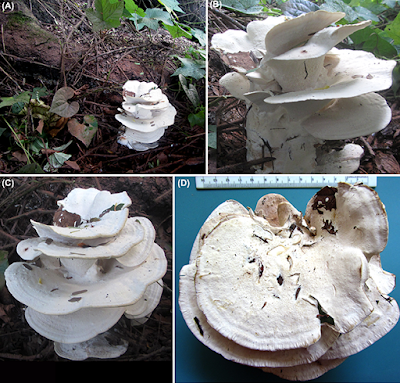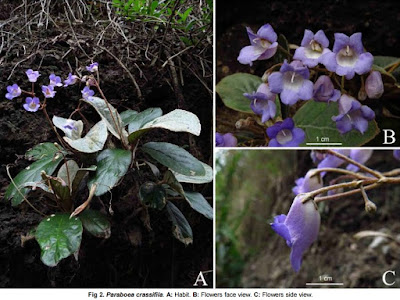[Most Recent Entries] [Calendar View]
Saturday, October 15th, 2016
| Time | Event | ||
| 12:51p | [Fungi • 2016] Mycorrhaphoides stalpersii • Morphology and Phylogeny reveal A Novel Hydnoid Taxon from India
Abstract Mycorrhaphoides gen. nov. and Mycorrhaphoides stalpersii sp. nov. are described and defined based on morphological details and phylogenetic inference of a hydnoid macrofungus collected in Acharya Jagadish Chandra Bose Indian Botanic Garden, Howrah (India). It is characterized by stipitate basidiomata with duplex context in stipe, presence of multi-clamped septa, and smooth and hyaline cystidia. Mycorrhaphoides Hembrom, K. Das & Hallenb. gen. nov. MycoBank: 816805. Type: Mycorrhaphoides stalpersii Hembrom, Nilsson, A. Parihar, K. Das, A. Baghela & S.K. Singh. Etymology: The genus name is motivated by the fact that the new genus shares some similarities with Mycorrhaphium, another hydnoid genus. Mycorrhaphoides stalpersii Hembrom, Nilsson, A. Parihar, K. Das, A. Baghela & S.K. Singh sp. nov. (Fig. 3 – 7) MycoBank: MB 816806. Type: India; West Bengal, Howrah, AJCBIBG, near bicentenary gate, 22 ° 33 ′ 49.6 ″ N, 88 ° 17 ′18.5 ″ E, 13 m a.s.l., on base of living tree trunk of Tamarindus indica L., 24 Oct 2015, K. Das, M.E. Hembrom & Parihar, KMA-15-45 (holotype: CAL, isotype: AMH). Etymology: The species name is chosen to commemorate Dr. Joost A. Stalpers for his contribution to hydnoid mycology. M. E. Hembrom, Kanad Das, R. Henrik Nilsson, Arvind Parihar, Abhishek Baghela, Nikita Mehta, S. K. Singh and Nils Hallenberg. 2016. Morphology and Phylogeny reveal A Novel Hydnoid Taxon from India: Mycorrhaphoides stalpersii gen. and sp. nov. Nordic Journal of Botany. DOI: 10.1111/njb.01256 | ||
| 1:48p | [Botany • 2016] Paraboea crassifila • A New Species of Paraboea (Gesneriaceae) from Danxia landform in Guangxi, China Abstract Paraboea crassifila, a new species of Gesneriaceae from Danxia landform in Guangxi, China is described and illustrated, based on morphological and anatomical features. Paraboea crassifila sp. nov. is reported firstly from Danxia landform in China, with the special feature of enlarged filaments differing from the others of Paraboea distributed in China. Paraboea crassifila is similar to Paraboea guilinensis L. Xu & Y.G. Wei in the habit, but it can be distinguished by the obovate to narrowly obovate leaf blade, the peduncle and calyx covered with ferrugineous matted indumentums, the corolla arachnoid outside, the enlarged filaments, and 3 staminodes. Keyword: Danxia landform, Gesneriaceae, new species, taxonomy
Paraboea crassifila is similar to Paraboea guilinensis L. Xu & Y.G. Wei in the habit, but it can be distinguished by the leaf blade obovate, narrowly obovate, rare oblong (vs. obovate-elliptic or elliptic), peduncles 7–12.5 cm long, covered with ferrugineous matted indumentums (vs. 3.5–6.5 cm long, glabrous), calyx with ferrugineous matted indumentum outside (vs. glabrous), corolla arachnoid outside (vs. glabrous), filaments 6–8 mm long, enlarged (vs. 4.5–5 mm long, geniculate near middle), staminodes 3 (vs. 2). Distribution and habitat: Paraboea crassifila is only found from type locality (Fig 3), and only four populations have so far been identified by us during field investigations in 2015. Paraboea crassifila grows on rock faces of Danxia landform, at an elevation between 130 and 280 m. Phenology: Flowering from March to April, and fruiting May to June. Etymology: The specific epithet 'crassifila' is derived from the enlarged filaments. Notes: The special feature of Paraboea crassifila is the enlarged filaments (Fig. 2 D and E; Fig. 3 G and H), which is reported firstly from the genus of Paraboea in China. Paraboea crassifila is similar to Paraboea guilinensis L. Xu & Y.G. Wei in the habit, but it is easily distinguished from the latter by some characters. A detailed morphological comparison of the two species is shown in Table 1. Jing Guo, Zhao-Cen Lu, Jing Liu and Wei-Bin Xu. 2016. Paraboea crassifila, A New Species of Paraboea (Gesneriaceae) from Danxia landform in Guangxi, China. Taiwania. 61(1); http://tai2.ntu.edu.tw/taiwania/abstract.p |
| << Previous Day |
2016/10/15 [Calendar] |
Next Day >> |




